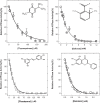A Therapeutic Connection between Dietary Phytochemicals and ATP Synthase
- PMID: 28831918
- PMCID: PMC5738703
- DOI: 10.2174/0929867324666170823125330
A Therapeutic Connection between Dietary Phytochemicals and ATP Synthase
Abstract
For centuries, phytochemicals have been used to prevent and cure multiple health ailments. Phytochemicals have been reported to have antioxidant, antidiabetic, antitussive, antiparasitic, anticancer, and antimicrobial properties. Generally, the therapeutic use of phytochemicals is based on tradition or word of mouth with few evidence-based studies. Moreover, molecular level interactions or molecular targets for the majority of phytochemicals are unknown. In recent years, antibiotic resistance by microbes has become a major healthcare concern. As such, the use of phytochemicals with antimicrobial properties has become pertinent. Natural compounds from plants, vegetables, herbs, and spices with strong antimicrobial properties present an excellent opportunity for preventing and combating antibiotic resistant microbial infections. ATP synthase is the fundamental means of cellular energy. Inhibition of ATP synthase may deprive cells of required energy leading to cell death, and a variety of dietary phytochemicals are known to inhibit ATP synthase. Structural modifications of phytochemicals have been shown to increase the inhibitory potency and extent of inhibition. Sitedirected mutagenic analysis has elucidated the binding site(s) for some phytochemicals on ATP synthase. Amino acid variations in and around the phytochemical binding sites can result in selective binding and inhibition of microbial ATP synthase. In this review, the therapeutic connection between dietary phytochemicals and ATP synthase is summarized based on the inhibition of ATP synthase by dietary phytochemicals. Research suggests selective targeting of ATP synthase is a valuable alternative molecular level approach to combat antibiotic resistant microbial infections.
Keywords: Microbial and mammalian F1Fo ATP synthase; antimicrobial phytochemicals; enzyme inhibition; molecular drug target; polyphenols.
Copyright© Bentham Science Publishers; For any queries, please email at epub@benthamscience.org.
Figures



Similar articles
-
Thiol oxidation of mitochondrial F0-c subunits: a way to switch off antimicrobial drug targets of the mitochondrial ATP synthase.Med Hypotheses. 2014 Aug;83(2):160-5. doi: 10.1016/j.mehy.2014.05.004. Epub 2014 May 17. Med Hypotheses. 2014. PMID: 24932580
-
A review on antimicrobial botanicals, phytochemicals and natural resistance modifying agents from Apocynaceae family: Possible therapeutic approaches against multidrug resistance in pathogenic microorganisms.Drug Resist Updat. 2020 Jul;51:100695. doi: 10.1016/j.drup.2020.100695. Epub 2020 Apr 8. Drug Resist Updat. 2020. PMID: 32442892 Review.
-
Novel Drugs Targeting the c-Ring of the F1FO-ATP Synthase.Mini Rev Med Chem. 2016;16(10):815-24. doi: 10.2174/1389557516666160211120955. Mini Rev Med Chem. 2016. PMID: 26864551 Review.
-
Synergistic interactions of phytochemicals with antimicrobial agents: Potential strategy to counteract drug resistance.Chem Biol Interact. 2019 Aug 1;308:294-303. doi: 10.1016/j.cbi.2019.05.050. Epub 2019 May 31. Chem Biol Interact. 2019. PMID: 31158333 Review.
-
Editorial: Phytochemicals and their Effects on Human Health.Curr Pharm Des. 2017;23(19):2695-2696. doi: 10.2174/1381612823999170419151503. Curr Pharm Des. 2017. PMID: 28425864 No abstract available.
Cited by
-
American Ginseng (Panax quinquefolium L.) as a Source of Bioactive Phytochemicals with Pro-Health Properties.Nutrients. 2019 May 9;11(5):1041. doi: 10.3390/nu11051041. Nutrients. 2019. PMID: 31075951 Free PMC article. Review.
-
Virtual Screening of Soybean Protein Isolate-Binding Phytochemicals and Interaction Characterization.Foods. 2023 Jan 6;12(2):272. doi: 10.3390/foods12020272. Foods. 2023. PMID: 36673362 Free PMC article.
-
Phytochemicals: potential alternative strategy to fight Salmonella enterica serovar Typhimurium.Front Vet Sci. 2023 May 16;10:1188752. doi: 10.3389/fvets.2023.1188752. eCollection 2023. Front Vet Sci. 2023. PMID: 37261108 Free PMC article. Review.
-
Potential Inhibitory Effect of Apis mellifera's Venom and of Its Two Main Components-Melittin and PLA2-on Escherichia coli F1F0-ATPase.Antibiotics (Basel). 2020 Nov 18;9(11):824. doi: 10.3390/antibiotics9110824. Antibiotics (Basel). 2020. PMID: 33218209 Free PMC article.
-
Immunomodulating Phytochemicals: An Insight Into Their Potential Use in Cytokine Storm Situations.Adv Pharm Bull. 2024 Mar;14(1):105-119. doi: 10.34172/apb.2024.001. Epub 2023 Jul 19. Adv Pharm Bull. 2024. PMID: 38585461 Free PMC article. Review.
References
-
- O’Neill J. Antimicrobial resistance: Tackling a crisis for health and wealth of nations. https://amr-review.org/sites/default/files/AMR
-
- Ling L.L., Schneider T., Peoples A.J., Spoering A.L., Engels I., Conlon B.P., Mueller A., Schäberle T.F., Hughes D.E., Epstein S., Jones M., Lazarides L., Steadman V.A., Cohen D.R., Felix C.R., Fetterman K.A., Millett W.P., Nitti A.G., Zullo A.M., Chen C., Lewis K. A new antibiotic kills pathogens without detectable resistance. Nature. 2015;517(7535):455–459. - PMC - PubMed
-
- World Health Organization. Antimicrobial Resistance: Global Report on Surveillance. 2014.
-
- Borges A., Saavedra M.J., Simões M. Insights on antimicrobial resistance, biofilms and the use of phytochemicals as new antimicrobial agents. Curr. Med. Chem. 2015;22(21):2590–2614. - PubMed
Publication types
MeSH terms
Substances
LinkOut - more resources
Full Text Sources
Other Literature Sources
Research Materials

